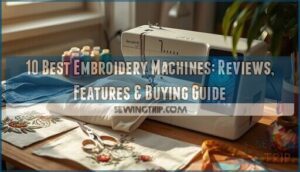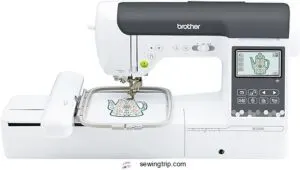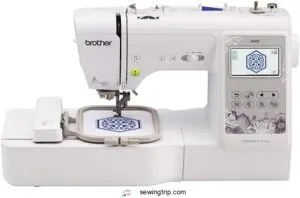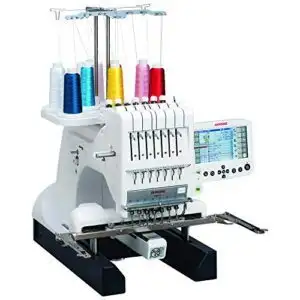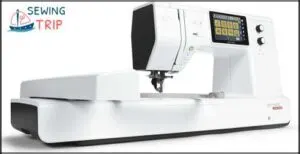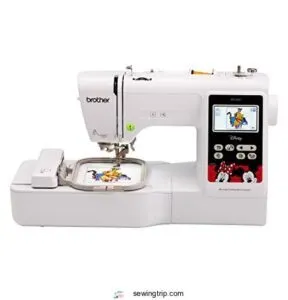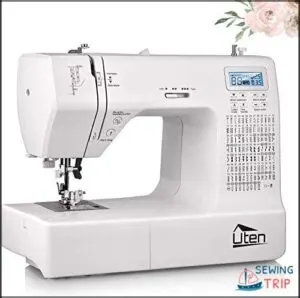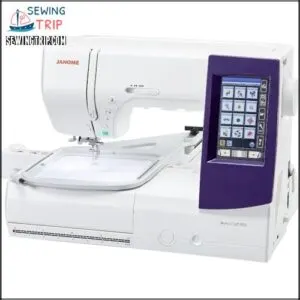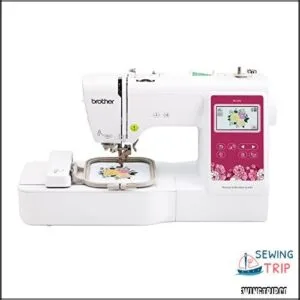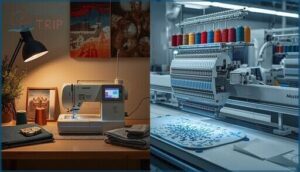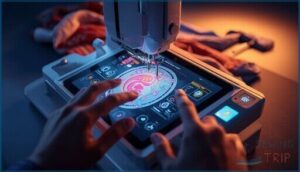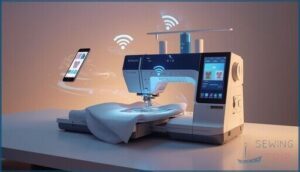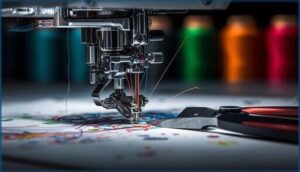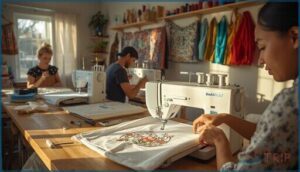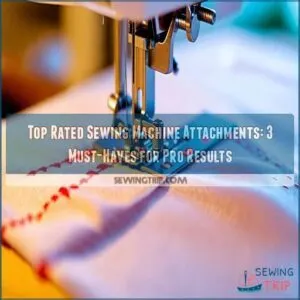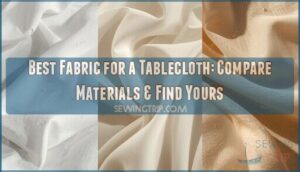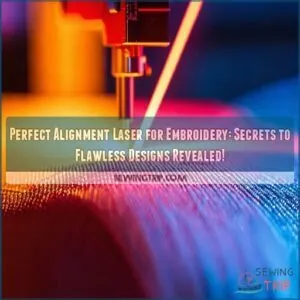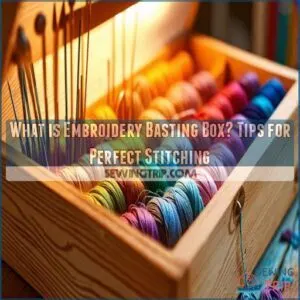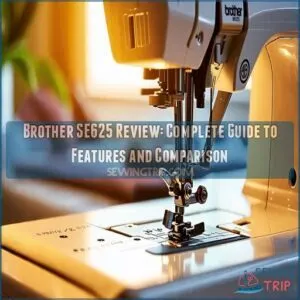This site is supported by our readers. We may earn a commission, at no cost to you, if you purchase through links.
Every year, more than 30 billion embroidery stitches are laid down by machines worldwide—most of them never seen by anyone but the maker. That’s the quiet power behind the best embroidery machines: they turn your ideas into tangible art, whether you’re customizing uniforms or adding flair to a denim jacket.
But not all machines handle thick canvas, slippery silk, or high-volume jobs with the same finesse. If you want crisp lettering and smooth curves, you need more than a pretty touchscreen. The right machine makes every stitch count, and finding it means knowing what features and real-world performance truly matter.
Table Of Contents
- Key Takeaways
- Best Embroidery Machines for 2024
- 1. Brother SE2000 Sewing Embroidery Machine
- 2. Brother SE1900 Sewing and Embroidery Machine
- 3. Brother SE600 Sewing Embroidery Machine
- 4. Janome MB-7 Seven Needle Embroidery Machine
- 5. Bernette B79 Sewing and Embroidery Machine
- 6. Brother PE535 Embroidery Machine For Beginners
- 7. Brother PE550D Disney Embroidery Machine
- 8. Portable Sewing and Embroidery Machine
- 9. Janome Horizon Embroidery Sewing Machine
- 10. Brother PE545 Wireless Embroidery Machine
- Key Features to Compare
- Choosing The Right Embroidery Machine
- Embroidery Machine Performance and Maintenance
- User Reviews and Real-World Experiences
- Frequently Asked Questions (FAQs)
- Conclusion
Key Takeaways
- Match your embroidery machine to actual project needs by considering needle count, hoop size, and fabric compatibility rather than chasing the highest price tag or most features.
- Single-needle machines suit home hobbyists doing simple monograms while multi-needle models handle commercial volume and complex color work, with entry prices starting around $379 versus $3,500.
- Real performance depends on regular maintenance like daily lint cleaning, needle replacement every 25-40 hours, and oil changes every 3-4 hours for commercial use to prevent the 86% of breakdowns caused by debris buildup.
- Wireless connectivity, automatic threading, and 4×4 to 5×7 inch hoops now define modern home machines, cutting setup time in half while brands like Brother and Janome lead in support quality and warranty coverage.
Best Embroidery Machines for 2024
The best embroidery machines for 2024 combine reliable performance with features that match your skill level and project goals. Whether you’re just starting out or running a small business, the right machine can make your creative work faster and more enjoyable.
Here are ten models that stand out for quality, functionality, and value.
1. Brother SE2000 Sewing Embroidery Machine
The Brother SE2000 excels as a computerized embroidery machine that combines sewing and embroidery capabilities in one package. You’ll get 193 builtin embroidery designs and a generous 5″ x 7″ embroidery field for larger projects.
The wireless LAN connection works with the Artspira App to simplify design transfers. User friendliness shines through its 3.7-inch touchscreen and automatic threading.
Stitch quality impresses at speeds up to 650 stitches per minute. Consider the machine weight of over 20 pounds and voltage needs of 120 volts when planning your workspace.
Best For: Hobbyists and home sewers who want a versatile machine that handles both everyday sewing projects and custom embroidery work without needing separate equipment.
- Large 5″ x 7″ embroidery field gives you more room for designs compared to entry-level machines, plus wireless connectivity makes transferring patterns quick and easy.
- 193 built-in embroidery designs and 241 sewing stitches mean you’ve got plenty of creative options right out of the box without buying extra design packs.
- Automatic threading and jump stitch trimming save time on tedious tasks, while the color touchscreen makes navigation simple even for beginners.
- Weighs over 20 pounds and doesn’t include a carrying case, so moving it around or taking it to classes becomes a hassle.
- The bobbin winder doesn’t stop automatically when full, which means you need to watch it manually to avoid overfilling.
- Requires 120-volt power and needs an adapter for international use, plus the Artspira app subscription adds ongoing costs if you want access to premium features.
2. Brother SE1900 Sewing and Embroidery Machine
Now discontinued but still highly regarded, the Brother SE1900 Sewing and Embroidery Machine delivers impressive stitch quality with 240 builtin sewing stitches and 138 embroidery designs. You’ll work with a 5″ x 7″ embroidery field and navigate through a color touchscreen that makes design customization straightforward. The user interface supports USB imports for expanding your pattern library.
Machine durability stands out with a 25-year limited warranty on mechanical parts. Market comparison shows it originally priced around $999 to $1,299, though some inventory dropped to $599 before discontinuation in 2023.
Best For: Intermediate sewers and crafters who want a reliable combo machine for both garment construction and medium-sized embroidery projects without breaking the bank.
- Strong feature set with 240 sewing stitches and 138 embroidery designs gives you plenty of creative options right out of the box.
- The 25-year limited warranty on mechanical parts shows Brother stands behind the build quality for the long haul.
- Large 5″ x 7″ embroidery field handles bigger designs with less rehooping compared to smaller machines in this price range.
- Only one hoop size included limits flexibility for smaller detail work or larger continuous designs.
- No wireless connectivity means you’re stuck using USB drives to import custom embroidery files.
- Discontinued in 2023 and replaced by the SE2000, so finding accessories or support might get trickier down the road.
3. Brother SE600 Sewing Embroidery Machine
The Brother SE600 offers solid project versatility with 103 built-in designs and a 3.7″ touchscreen that simplifies pattern navigation. You’ll handle everything from lightweight silk to heavy denim thanks to consistent stitch quality across fabric types.
Design import through USB expands your creative options beyond the included embroidery patterns. Beginner-friendliness shows in the automatic needle threader and one-step buttonholes.
Maintenance needs stay minimal with straightforward cleaning routines. This sewing and embroidery machine combo delivers reliable performance at $391 to $700, making it accessible for learning the craft.
Best For: Beginners and intermediate crafters who want a reliable combo machine for garment sewing, monogramming, and small embroidery projects without spending over $700.
- Handles multiple fabric weights smoothly, from silk to denim, with consistent stitch quality and 710 stitches per minute sewing speed.
- USB design import and 80 built-in embroidery designs give you plenty of creative options beyond basic patterns.
- Automatic needle threader, push-button thread cutter, and one-step buttonholes make setup and operation genuinely beginner-friendly.
- 4″ x 4″ embroidery area limits you to smaller designs and requires repositioning for larger projects.
- No wireless connectivity means you’re stuck using USB cables to transfer custom embroidery files.
- Some users report noticeable motor noise during extended sewing or embroidery sessions.
4. Janome MB-7 Seven Needle Embroidery Machine
Commercial use demands a seven-needle system that cuts thread-change downtime in half. The Janome MB-7 runs at 800 stitches per minute while maintaining professional stitch quality across a 9.4″ x 7.9″ field. Independent bobbin winding keeps you working during active projects.
This multineedle embroidery machine features programmable jump thread trimming and auto-return after breaks. Maintenance tips include daily race cleaning and monthly sensor checks.
At $5,999, it competes with embroidery machines like the Janome Memory Craft 9850 for small business owners serious about consistent output.
Best For: Small business owners and professional embroiderers who need consistent, high-volume output with minimal thread-change interruptions.
- Seven-needle system cuts thread-change time in half and runs at 800 stitches per minute for fast, professional results
- Independent bobbin winding lets you prep bobbins during active embroidery, keeping workflow smooth
- Auto-return after thread breaks and programmable jump thread trimming reduce downtime and cleanup work
- Some users report thread tension issues and breakage despite the machine’s advanced features
- No automatic threading—you’ll handle needle threading and tricky bobbin setup manually
- Limited embroidery area (9.4″ x 7.9″) may restrict larger design work compared to industrial models
5. Bernette B79 Sewing and Embroidery Machine
Your dual-purpose workhorse arrives with 500 stitches and 208 builtin designs spread across a 10.2″ x 6.3″ embroidery area. The Bernette B79 pairs touchscreen navigation with a programmable foot control that speeds through fabric layers.
Its dual feed system grips denim and silk chiffon with equal confidence, while Stitch Designer software lets you build custom designs from scratch. Magnetic hoops like MaggieFrame cut setup time by 90%.
This sewing machine runs 1,000 stitches per minute with 10-year warranty coverage on mechanical parts. At $1,999, it bridges hobbyist ambition and semi-pro demands.
Best For: Sewers and embroidery enthusiasts who want a feature-rich machine that can handle everything from delicate fabrics to heavy-duty projects without constantly switching equipment.
- Handles serious variety—500 stitches, 208 embroidery designs, and a dual feed system that grips silk and denim equally well without skipping stitches.
- Fast and efficient workflow with 1,000 stitches per minute, programmable foot control, and automatic thread cutting that saves you from constant manual adjustments.
- Built to last with a 10-year warranty on mechanical parts and robust construction that holds up under both home and commercial use.
- Navigation can be confusing—some users struggle with the menu system and find the manual lacking in detail, requiring extra research or support.
- Accessories and replacement parts aren’t always easy to track down, which can be frustrating when you need something specific.
- At $1,999, it’s a significant investment that might feel steep for casual hobbyists who won’t use all the advanced features.
6. Brother PE535 Embroidery Machine For Beginners
You’ll gain access to 80 built-in designs and nine font styles with the Brother PE535 Embroidery Machine—a beginner-friendly workhorse that stitches 400 patterns per minute across its 4″ x 4″ hoop. The 3.2″ touchscreen walks you through automatic needle threading and drag-and-drop design placement.
Import custom embroidery designs via USB port. Thread tension issues resolve quickly with included troubleshooting tips. Its 25-year warranty backs stitch quality through circuit boards and chassis.
At under $500, this embroidery machine for beginners delivers pro-level results without the learning curve.
Best For: Beginners and hobbyists who want to jump into embroidery without wrestling with complicated settings or spending a fortune.
- 80 built-in designs and 9 fonts give you plenty to work with right out of the box, plus you can load custom designs through the USB port.
- The 3.2″ touchscreen and automatic needle threading make setup fast and painless, even if you’ve never touched an embroidery machine before.
- Stitches at 400 SPM with consistent quality that rivals pricier models, all backed by a 25-year warranty.
- The 4″ x 4″ hoop limits you to smaller projects—larger designs will need to be split up or skipped entirely.
- It’s embroidery-only, so you’ll still need a separate sewing machine for regular stitching work.
- You’ll need to budget for extras like thread, stabilizer, and potentially pricey digitizing software if you want to create your own custom designs.
7. Brother PE550D Disney Embroidery Machine
You’ll stitch 45 licensed Disney patterns straight out of the box with the Brother PE550D Disney Embroidery Machine—a $350 gateway to character-driven projects. This embroidery machine reviews well for beginner friendliness thanks to its 3.2″ touchscreen and automatic needle threader.
Technical specs include 125 total designs and nine font styles within a 4″ x 4″ hoop. Machine limitations show in that compact embroidery area and embroidery-only function.
Disney-themed embroidery fans accept the trade-off: affordability meets Mickey Mouse without digitizing software costs.
Best For: Beginners and hobbyists who want to embroider Disney characters without spending thousands on digitizing software or dealing with complicated setup.
- 45 licensed Disney designs built right in, plus 80 more patterns and 9 fonts so you can start stitching immediately
- Automatic needle threader and 3.2″ color touchscreen make operation simple enough for first-timers
- $350 price point includes a 25-year warranty and lifetime tech support, which is solid value for an embroidery-only machine
- 4″ x 4″ embroidery area limits you to small projects—no full-back jacket designs here
- Can’t sew regular seams since it’s embroidery-only, so you’ll need a separate sewing machine for garment construction
- Custom designs require conversion to PES files and expensive digitizing software (starting around $1,000) if you want to go beyond the built-in library
8. Portable Sewing and Embroidery Machine
You need beginner-friendly embroidery machines that move from room to room without a workout. Portable sewing and embroidery machines weigh 10 to 30 pounds and measure around 18 to 24 inches wide.
Compact embroidery machines deliver 4″ x 4″ to 5″ x 7″ work areas with 600-700 stitches per minute. Adaptable sewing and embroidery models like the Brother SE700 combine 200 stitches with 135 designs for project versatility.
Travel sewing becomes practical when lightweight models pack automatic threading and USB connectivity into compact designs under 20 pounds.
Best For: Hobbyists, beginners, and small business owners who need a lightweight machine that handles basic embroidery and sewing projects without taking up permanent workspace.
- Weighs between 10-30 pounds with compact dimensions (18-24″ wide), making it easy to move between rooms or pack for classes and craft events.
- Offers 4″ x 4″ to 5″ x 7″ embroidery areas with 600-700 stitches per minute, plus 135-200 built-in designs that cover most beginner to intermediate projects.
- Features automatic needle threading, USB connectivity, and LCD screens that simplify setup and let you transfer designs without complicated software.
- Thread breaking, needle breakage, and jamming issues reported by some users, particularly with lower-end models that use more plastic components.
- Instruction manuals often lack detail, forcing beginners to search YouTube tutorials or online forums to figure out basic operations.
- Replacement parts like bobbin covers can be hard to find, and some customers receive refurbished units instead of new machines despite product listings.
9. Janome Horizon Embroidery Sewing Machine
The Janome Horizon Memory Craft 12000 combines precision embroidery with sewing machine versatility in one compact frame. You get 338 built-in embroidery designs and 425 stitches controlled through a full-color touchscreen. Design integration happens smoothly through USB connectivity, while speed performance reaches 1,000 stitches per minute for embroidery work.
The 9″ x 12″ embroidery area accommodates substantial projects. User feedback consistently praises quiet operation and straightforward controls.
Maintenance needs stay minimal with sealed components requiring only regular bobbin cleaning. Market comparison shows competitive pricing despite sophisticated features.
Best For: Intermediate to experienced sewers who want professional-grade embroidery and sewing capabilities in one machine without the bulk of competing models.
- 338 embroidery designs and 425 stitches with a responsive touchscreen make design work fast and intuitive
- Runs quietly at up to 1,000 embroidery stitches per minute with minimal maintenance needed
- Large 9″ x 12″ embroidery area handles bigger projects while staying compact compared to Bernina and Brother alternatives
- Only recognizes.JEF embroidery file format, limiting design import options
- Heavy build makes moving it around difficult
- Discontinued model means you’ll need to hunt through dealers for availability, though often at good prices
10. Brother PE545 Wireless Embroidery Machine
The Brother PE545 brings wireless connectivity to home embroidery with LAN transfer that eliminates USB drives. You get 135 embroidery designs and 10 fonts managed through a 3.7-inch touchscreen. The 4″ x 4″ embroidery area works well for personalization projects.
Wireless setup connects to PC or mobile devices running the Artspira app for software integration. Stitch quality remains consistent at 400 stitches per minute.
Customer reviews highlight reliable design editing features. Machine lifespan reaches 5 to 25 years with proper maintenance. This embroidery machine suits beginners seeking modern workflow convenience.
Best For: Home crafters and small business owners who want wireless design transfer and built-in patterns for personalized embroidery projects up to 4″ x 4.
- Wireless LAN and Artspira app integration let you send designs from your phone or computer without fumbling with USB drives.
- 135 pre-loaded designs and 10 fonts give you plenty of options right out of the box, so you can start stitching immediately.
- User-friendly 3.7-inch touchscreen makes editing and previewing designs straightforward, even if you’re new to embroidery.
- The 4″ x 4″ embroidery area limits you to smaller projects, so larger designs require splitting or won’t fit at all.
- Some users report thread tension issues and occasional error messages that need troubleshooting or technical support.
- It’s embroidery-only, meaning you’ll need a separate machine if you want standard sewing functions.
Key Features to Compare
Not all embroidery machines are built the same. The features you choose will shape how much you can accomplish and how smoothly your projects run.
Here’s what to compare before you buy.
Single-Needle Vs Multi-Needle Machines
Choosing embroidery machines often comes down to one big decision: single needle or multineedle embroidery machines. Your project needs and production volume will guide this choice. Here’s what separates them:
- Design Complexity: Single-needle models handle one color at a time, while multi-needle machines run multiple colors automatically
- Space Requirements: Single-needle units fit home studios easily; multi-needle setups need dedicated commercial space
- Cost Analysis: Entry single-needle machines start around $379, but multi-needle models begin near $3,500
- Maintenance Needs: Multi-needle systems demand professional servicing and regular calibration
For basic tasks, a user might choose single needle machines due to their simplicity.
Built-in Design Libraries and Pattern Options
Most entry-level machines pack 80-200 embroidery designs and patterns, while mid-range models offer 150-300 builtin stitches. High-end machines exceed 300 custom designs. You’ll find alphabets, decorative motifs, and utility patterns.
Design variety matters less than file compatibility—look for PES and DST support for design upload freedom. Editing capabilities like resizing and rotation save time. Many machines now support design updates through software, expanding your creative options beyond factory patterns.
Understanding embroidery file formats is key for error-free stitching.
Touchscreen Controls and Display Size
Display technology shapes how easily you control your machine. Modern LCD color touchscreens range from 3.2″ on entry models to 10.1″ on professional units like the Brother Stellaire. Larger screens correlate with developed editing tools and higher resolution—mid-range machines offer 5-7″ displays while budget options stay around 4-5″.
Touchscreen functionality cuts setup time by half and reduces errors through clear visual control.
Wireless Connectivity and Design Transfer
Wireless capability transforms how you load designs. About 70-80% of 2024 models include Wi-Fi for direct design transfer from mobile apps like Brother Artspira or cloud storage platforms. Bluetooth capabilities offer another path for device pairing.
You’ll cut setup time in half compared to the traditional USB port method. Remote monitoring and automatic firmware updates keep your machine current without manual work.
Hoop Sizes and Embroidery Area
Your project scope expands or shrinks with hoop capacity. Most home embroidery machines offer 4×4 or 5×7 inch hoops, while high-end models like the Husqvarna Designer Epic 3 reach 18×17 inches. This embroidery area directly affects design scaling and fabric tension control.
- Small hoops (4×4) excel at monograms and detailed motifs with tight stitch accuracy
- Medium sizes (5×7) balance versatility for quilt blocks and garment designs
- Large embroidery area machines eliminate re-hooping on banners and jacket backs
Automatic Threading and Thread Cutters
Threading systems save serious time when you’re switching colors mid-project. Automatic threaders guide thread through needle eyes with sensor precision, while automatic cutters eliminate manual trimming between design sections.
Boost productivity by up to 20% with automatic thread cutting, turning six-second pauses into smooth transitions. Needle technology paired with smart fabric handling reduces thread breaks and keeps tension consistent across delicate materials.
Choosing The Right Embroidery Machine
Finding the right embroidery machine isn’t about buying the most expensive model. It’s about matching features to your actual projects and skill level.
The best embroidery machine is the one whose features fit your projects and skill level, not just its price tag
Here are the key factors you need to think about before making your purchase.
Matching Machine Type to Project Needs
Your embroidery machine should fit what you actually plan to make. Single-needle machines work well for simple monograms and patches. Multi-needle computerized embroidery machines handle complex multi-color work better.
Consider needle count, hoop sizes, and fabric selection for your typical projects. If you’re stitching jacket backs or quilts, look at larger compact embroidery machines with adjustable stitch regulation for proper project scaling.
Ease of Use for Beginners and Experts
You want a machine that won’t frustrate you right out of the gate. Straightforward interfaces like the Brother SE2000’s 5×7-inch touchscreen make design selection simple for beginners. Automatic threading reduces setup hassles. Speed control lets you start slow and build confidence. Wireless connectivity streamlines design transfer.
Easy-to-use embroidery machines with these beginner-friendly features let experts work faster while making embroidery machine ease of use accessible to newcomers.
Fabric and Thread Compatibility
Ever notice how fabric selection can make or break your embroidery? Linen and quilting cotton offer stability, while denim and canvas handle bold thread colors and heavy thread weight.
Needle sizing and stabilizer types matter for smooth embroidery tension and crisp results. Make sure your machine accommodates proper needle tension, thread cutting, and embroidery area for impeccable stitching across materials.
Brand Reputation and Customer Support
Your machine is only as reliable as the support behind it. Brother SE1900 and Bernina earn strong customer reviews and ratings for responsive service response and detailed manuals. Ricoma balances affordability with support quality, though some users note slower response times.
Check embroidery machine pros and cons, warranty coverage, and authorized service centers. Solid reputation management and brand loyalty often signal better long-term satisfaction in any embroidery machine buying guide.
Price Range and Value for Money
Budget options start around $250 for hobbyists, like the Brother PE535 at $379. Mid-range machines run $600–$3,000, offering better features for small business use. Commercial units hit $16,000+. Your cost analysis should weigh per-item savings: you’ll spend $0.30–$1.50 per 1,000 stitches versus $5–$50 outsourcing. Investment returns matter most.
- Entry machines offer ease of use but limited hoop sizes
- Mid-range models balance additional features with affordability
- Multi-needle brands deliver faster production for serious work
Embroidery Machine Performance and Maintenance
Buying an embroidery machine is just the start. How well it performs over time depends on speed, precision, and how you care for it.
Let’s look at what keeps these machines running smoothly and what to expect from warranties and service support.
Stitch Speed and Precision
High-performance embroidery machines balance stitch speed with pinpoint needle accuracy. Home machines stitch between 600 and 1000 SPM, while commercial models reach 1500 SPM. Motor efficiency paired with servo technology drives consistent results.
Automatic thread tension and fabric stabilization keep your designs sharp at any speed. Sophisticated stitch regulation ensures embroidery machine performance stays precise, even when complex stitching order demands rapid needle movements across multiple colors.
Durability and Long-Term Reliability
Speed matters less if your machine won’t last. Material Selection determines embroidery machine durability—aluminum and steel frames provide structural integrity that lasts decades.
Component Lifespan varies: motors run 1,000 to 3,000 hours, circuit boards last three to five years. Maintenance Schedules prevent costly failures.
Repair Costs for motors range from $100 to $250, while Warranty Coverage spans one to ten years depending on the brand.
Maintenance Tips and Cleaning
Longevity depends on how you care for your embroidery machine. Regular servicing catches issues before they escalate into expensive repairs. Here’s your maintenance checklist:
- Daily Cleaning removes lint from the bobbin area after every session—86% of breakdowns trace back to excess debris.
- Oil Replacement every three to four hours prevents friction wear in commercial settings.
- Needle Care means swapping needles every 25–40 hours to avoid thread breakage.
- Dust Prevention with covers reduces particle buildup by 33% weekly.
Professional servicing extends machine life by 23%.
Warranty and Service Options
Protection matters when you’re investing in embroidery machines. Most warranties cover one to two years, but brands like Ricoma and BERNINA offer up to five years on specific components. Brother SE1900 users benefit from responsive two-day support. Extended warranties and service plans shield you from repair costs averaging $75 to $300.
| Coverage Type | Duration | What’s Included |
|---|---|---|
| Standard Warranty | 1-2 years | Manufacturing defects, electrical issues |
| Extended Warranties | 3-5 years | Parts, labor, circuit boards |
| Maintenance Support | Varies | On-site repair, remote diagnostics |
Authorized service centers preserve warranty claims—third-party repairs void coverage.
User Reviews and Real-World Experiences
Choosing the right embroidery machine often comes down to real experiences from people who use them every day.
You’ll find honest feedback about how these models perform at home and in business settings.
Here’s what users say about the machines that stand out.
Performance in Commercial and Home Settings
Ever wondered how embroidery machine performance shifts from home use to commercial scale? In shops, computerized embroidery machines deliver top stitch quality and speed, handling large designs with ease. Commercial embroidery machine advantages shine in bulk orders, while machine durability and versatility matter most for personal projects.
At home, you’ll notice reliable stitch speed and fabric compatibility, especially with durable models.
Notable Pros and Cons Reported by Users
User feedback paints a clear picture of embroidery machine pros and cons. You’ll spot strengths in user-friendly embroidery machines and features, but also common design limitations. For practical selection, consider these highlights:
- Fast automatic threading
- Limited hoop sizes for beginners
- Reliable construction on high-end models
- Cost factors drive upgrade choices
- Customer support varies widely across brands
Embroidery machine reviews reveal what really matters.
Popular Models for Small Businesses
Thinking about boosting production capacity? Small business owners often compare models like the Brother SE700 and Baby Lock Solaris for their quick ROI timeframe and reliable commercial embroidery features.
Multi-needle embroidery machines stand out for speed and color flexibility. Brand reputation matters—Brother and Janome lead for support and durability.
Prioritize features that fit your workflow before choosing your ideal embroidery machine for small business.
User Satisfaction With Features and Upgrades
Curious what sets a flexible machine apart? Most embroiderers praise user-friendly features and performance durability. Online reviews highlight these top five points:
- Feature Satisfaction—automatic threading saves time.
- Software Updates—boost speed and design options.
- Brand Reliability—Brother and Bernina lead.
- Embroidery machine ease of use—straightforward touchscreens.
- Value Perceptions—additional features justify the investment for most users.
Frequently Asked Questions (FAQs)
What are the most common thread brands for Pfaff embroidery machines?
If you crave thread quality and color options, Madeira and Isacord top the charts for Pfaff embroidery machines. They’re trusted for strength, vibrant hues, and smooth stitching, making them clear favorites in brand comparison and user preferences.
What features should I look for in an industrial embroidery machine?
Look for machine automation, sophisticated thread management, high stitch quality, and fast operational speed. Prioritize large embroidery area machines, broad design capacity, and sturdy build.
Choosing embroidery machines with reliable features streamlines workflow and boosts productivity in demanding environments.
How do I determine the appropriate price for my embroidery services?
To set prices for your embroidery services, use Pricing Strategies like cost-plus or per-stitch methods. Factor in Cost Calculation, Market Research, and Profit Margins.
Competitive Analysis helps you stay in line with embroidery trends and custom designs.
Can embroidery machines work with metallic threads?
Embroidery machines can handle metallic threads with the right Thread Compatibility and Embroidery Settings.
For Metallic Stitching, vertical spool pins, sophisticated tension, and proper Thread Management boost stitching accuracy.
Machine Upgrades and trending thread colors further expand your creative embroidery trends.
How noisy are embroidery machines during operation?
You’ll notice embroidery machines like the Brother SE1900 generally run at sound levels around 60–65 decibels. Quiet operation matters, especially in home spaces.
Noise reduction and stable machine vibration help keep operational decibels comfortable for your embroidery area.
Are embroidery machines compatible with Mac computers?
Did you know over 40% of embroidery software now accommodates Mac Software? While embroidery machines rely on Digital Compatibility and Machine Integration, most use Cross Platform embroidery software.
Direct USB port connections need Embroidery Drivers, but design transfer is usually effortless.
Can I create custom designs without internet access?
You can create custom designs offline using embroidery software, then transfer them by USB. Most machines support file compatibility for custom patterns, allowing digital editing and uploading custom designs without internet.
Offline designing keeps your creative workflow secure and independent.
What safety features do embroidery machines include?
Don’t put all your eggs in one basket—modern machines pack in Electrical Guards, Vibration Control, and Safety Certifications.
You’ll find Operator Protection with Mechanical Locks, automatic needle threader, thread trimming, automatic thread cutting, and independent bobbin winder for safer use.
Conclusion
Sure, you could keep scrolling through reviews like you’re decoding ancient hieroglyphics—or you could just pick one of the best embroidery machines and start stitching. The truth is, no machine magically transforms you into an artist overnight. But the right one stops fighting you on every seam.
Match your project goals to the features that matter. Test your fabric. Clean your needles. Then let those billions of stitches do what they do best: make your vision real.
- https://sewinginsight.com/reviews/brother-se1900-sewing-and-embroidery-machine/
- https://maggieframestore.com/blogs/maggieframe-news/brothers-embroidery-machine-guide-models-features-and-expert-tips
- https://yousewandsew.com/best-sewing-machine-reviews/brother-se1900/
- https://sewfinesse.com/sewing/sewing-machine/brother-se1900-review/
- https://ssew.com/budget-embroidery-machine-choices/

